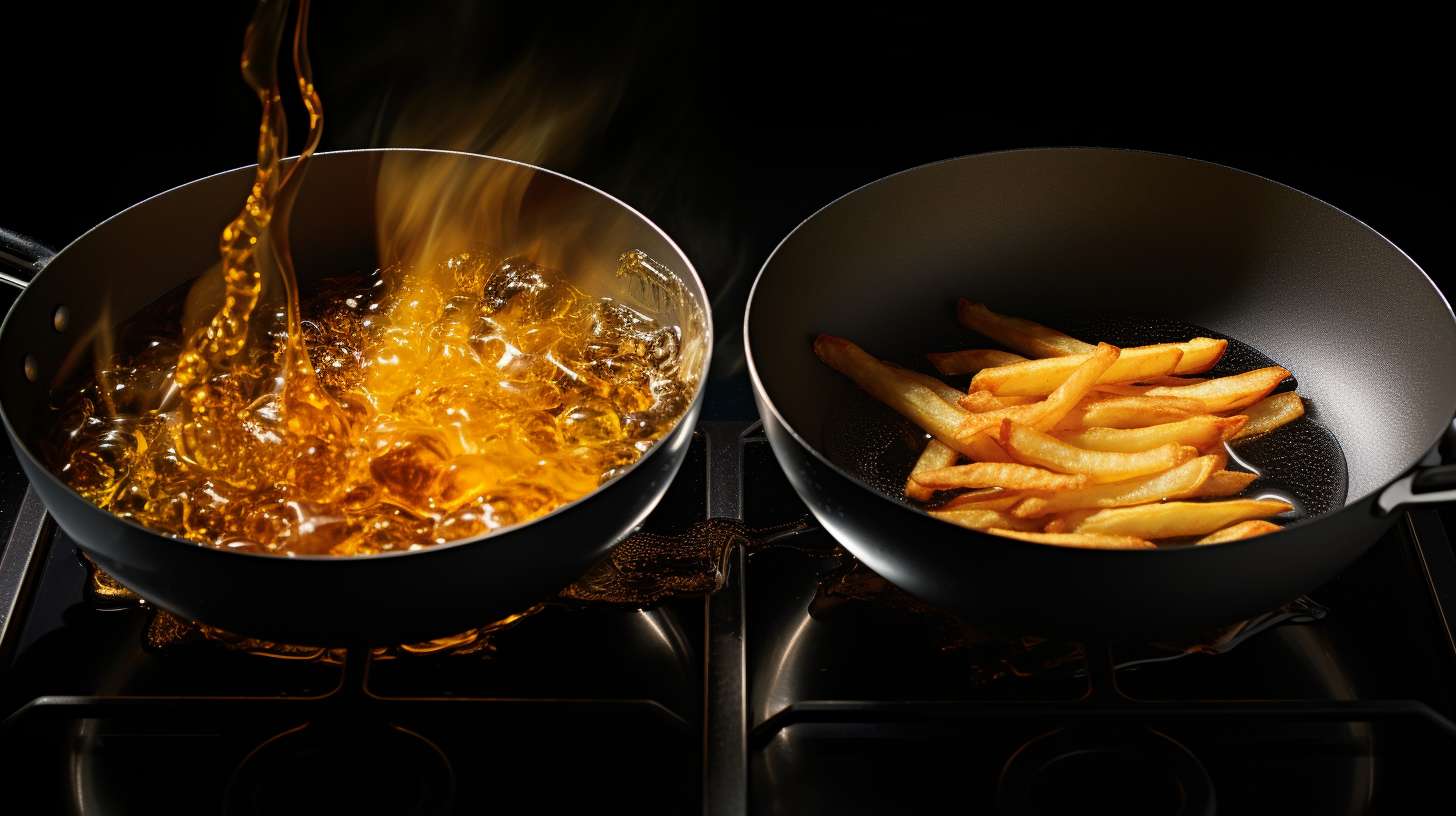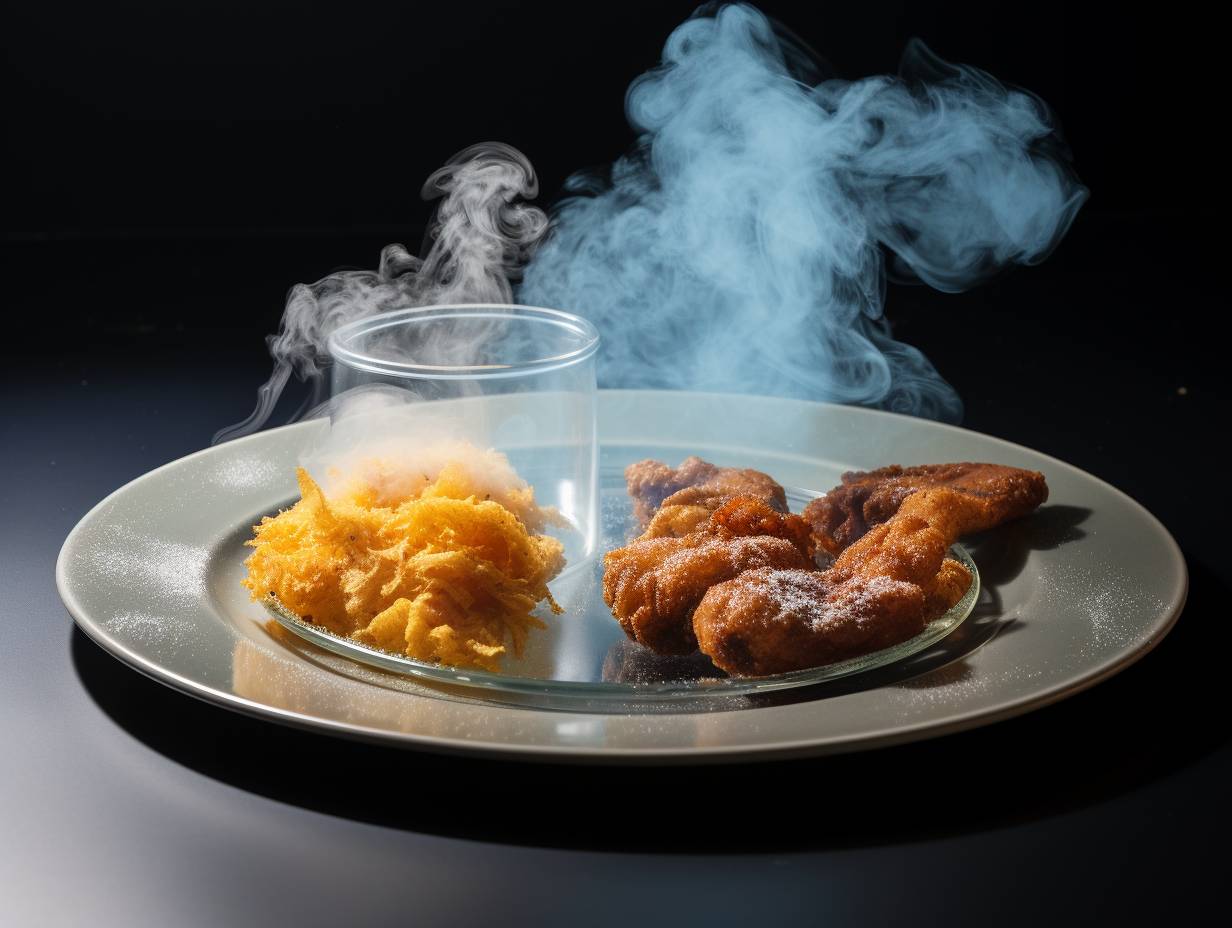
Acrylamide Air Fryer Vs Deep Fryer
Table Of Contents

Do you love the crispy, golden goodness of fried foods but worry about the health risks? Well, here’s some good news. You can now enjoy your favorite fried treats with less guilt.
In this article, we’ll explore the fascinating world of acrylamide, a potentially harmful chemical formed when cooking certain foods at high temperatures.
Discover how air fryers and deep fryers differ in their impact on acrylamide levels, and find out which one is the healthier choice for you.
Key Takeaways
- Acrylamide is a chemical that forms naturally in some foods during high-temperature cooking methods like frying and can be linked to an increased risk of cancer and neurological damage in high doses.
- Air fryers reduce acrylamide formation by using rapid air circulation, minimal oil usage, and precise temperature control, offering health benefits such as lower cancer risks compared to deep frying.
- Deep frying increases acrylamide levels in the final product, and longer deep frying times and foods with higher sugar and starch content produce more acrylamide.
- Air frying produces lower levels of acrylamide compared to deep frying, making it a healthier option in terms of acrylamide levels. However, the choice between air frying and deep frying ultimately depends on personal preferences and health goals.
Acrylamide: What You Need to Know
Acrylamide poses potential health risks, and understanding its effects is crucial for anyone using an air fryer or deep fryer. Acrylamide is a chemical that forms naturally in some foods, especially starchy ones, during high-temperature cooking methods like frying.
Research has shown that acrylamide in food may be linked to an increased risk of cancer, as well as neurological damage in high doses. Therefore, minimizing acrylamide exposure is important for your health.
To do this, you can follow a few simple steps. Firstly, avoid overcooking your food and aim for a light golden color instead of a dark brown. Secondly, soak potatoes in water before frying to reduce acrylamide formation. Lastly, try alternative cooking methods like baking or steaming, which produce lower levels of acrylamide.
How Air Fryers Reduce Acrylamide Formation

To reduce acrylamide formation, you can use an air fryer instead of a deep fryer. Here’s how air fryers help in reducing acrylamide formation:
-
Rapid Air Circulation: Air fryers use hot air to cook food, circulating it at high speed. This helps in evenly cooking the food and reducing the cooking time, which in turn reduces acrylamide formation.
-
Minimal Oil Usage: Air fryers require only a small amount of oil to achieve a crispy texture. Compared to deep fryers that submerge food in oil, air fryers significantly reduce the exposure of food to oil, thereby reducing acrylamide formation.
-
Temperature Control: Air fryers allow precise temperature control, ensuring that food is cooked at the optimal temperature. This helps in minimizing acrylamide formation, as cooking food at lower temperatures can reduce the formation of this chemical compound.
-
Health Benefits: By reducing acrylamide formation, air fryers offer health benefits such as lower risks of cancer and other health implications associated with high acrylamide intake. Using air fryers can be a healthier alternative to deep frying, allowing you to enjoy your favorite crispy foods with less acrylamide.
The Impact of Deep Frying on Acrylamide Levels

When deep frying food, you inadvertently increase the levels of acrylamide present in the final product. Deep frying techniques involve submerging food in hot oil, causing a chemical reaction between the amino acid asparagine and reducing sugars. This reaction leads to the formation of acrylamide, a potentially harmful substance.
Acrylamide has been linked to several health risks, including an increased risk of cancer and potential damage to the nervous system. The longer you deep fry food, the higher the level of acrylamide that’s produced. Additionally, the type of food being fried can also impact the acrylamide levels. Foods with higher sugar and starch content, such as potatoes and bread, tend to produce more acrylamide when deep fried.
It’s important to be aware of these risks when considering deep frying as a cooking method.
Comparing Acrylamide Levels in Air Fried and Deep Fried Foods

When comparing the acrylamide levels in air fried and deep fried foods, you’ll find significant differences. Here are four key points to consider:
-
Air fryer vs oven baked: Air frying has been found to produce lower levels of acrylamide compared to traditional deep frying. This is because air frying uses hot air circulation to cook the food, resulting in a crispy texture without the need for excessive oil.
-
Acrylamide in homemade vs store bought fried foods: Homemade fried foods tend to have lower acrylamide levels compared to store-bought ones. This is because you have control over the ingredients and the cooking process. Store-bought fried foods often undergo industrial processing, which may involve higher temperatures and longer cooking times, leading to increased acrylamide formation.
Making the Healthiest Choice: Air Fryer or Deep Fryer?
If you want to make the healthiest choice between an air fryer and a deep fryer, consider the nutritional benefits of each cooking method. Both have their pros and cons, so choosing the best option depends on your personal preferences and health goals.
Air fryers use hot air circulation to cook food, requiring little to no oil. This can significantly reduce the amount of fat and calories in your meals, making it a healthier option.
On the other hand, deep fryers submerge food in hot oil, resulting in a crispy and indulgent texture. However, this method adds a significant amount of fat and calories to your food.
When it comes to making the healthiest choice, the air fryer is generally considered a better option. It allows you to enjoy crispy and flavorful food without the excess oil and calories.
However, if you occasionally crave the deep-fried taste and texture, using a deep fryer in moderation can still be part of a balanced diet. Ultimately, it’s about finding a cooking method that aligns with your health goals and preferences.
Frequently Asked Questions
Are There Any Health Risks Associated With Consuming Acrylamide?
There are health risks associated with consuming acrylamide. To minimize its formation in cooking, avoid overcooking starchy foods and opt for healthier cooking methods like baking, steaming, or grilling.
What Are Some Common Sources of Acrylamide in Our Diet?
To reduce acrylamide exposure, be aware of common sources in your diet. Processed foods, like potato chips and French fries, are some culprits. By making healthier choices, you can minimize your intake.
How Does the Cooking Temperature Affect the Formation of Acrylamide?
When cooking at high temperatures, acrylamide can form due to the Maillard reaction. The longer you cook food, the more acrylamide can develop. It’s important to be mindful of cooking times to reduce acrylamide exposure.
Can the Use of Certain Cooking Oils Affect the Levels of Acrylamide in Fried Foods?
Using certain cooking oils can impact the levels of acrylamide in fried foods. Factors like the type of oil used, its smoke point, and the cooking temperature all play a role in acrylamide formation.
Are There Any Other Cooking Methods That Can Help Reduce Acrylamide Formation Besides Air Frying and Deep Frying?
Looking for other ways to reduce acrylamide formation? Try grilling techniques or baking alternatives. These methods can provide tasty alternatives to air frying and deep frying while helping to lower acrylamide levels in your favorite foods.
Conclusion
In the battle between air fryers and deep fryers, the winner in terms of reducing acrylamide formation is clear. Air fryers prove to be the healthier choice, as they significantly decrease acrylamide levels in foods.
So, if you want to enjoy crispy and delicious meals without compromising your health, it’s time to make the switch to an air fryer. Your taste buds and your body will thank you.
Disclaimer: Some information is provided through AI. Users should always conduct their own research and consult with qualified professionals before making any decisions.Affiliate information declaration: We may earn revenue from the products referred on this page and participate in affiliate programs.


